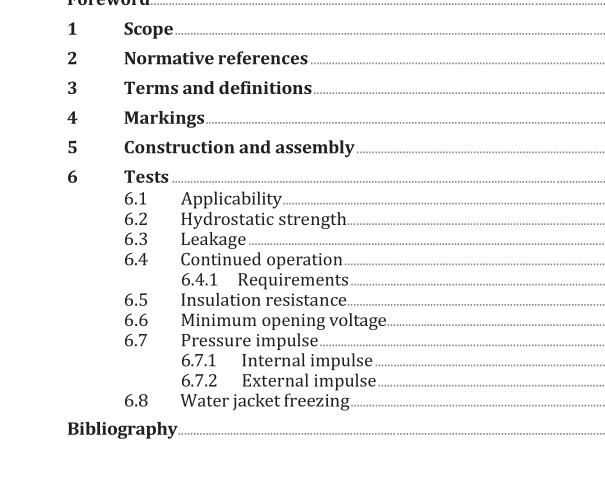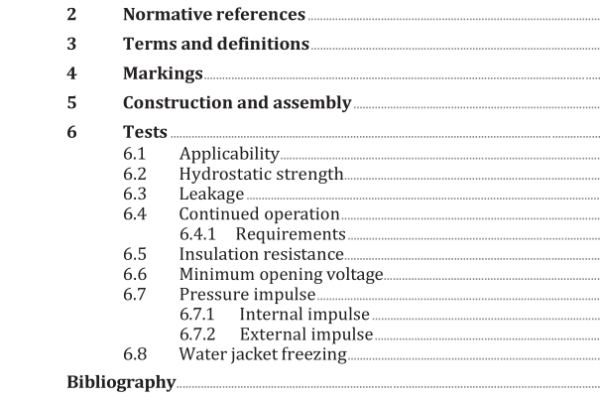ISO 20766-14:2022 pdf download – Road vehicles — Liquefied petroleum gas (LPG) fuel system components — Part 14: Vaporizer/pressure regulator.
b) Cycle the inlet pressure of the regulator for 1 % of the total number of cycles at room temperature from 100 % to 50 % of the working pressure. The duration of each cycle shall be no less than 10 s. c) The regulator shall comply with 6.3 at room temperature at the completion of this test. d) Repeat the cycling procedure of a) at 120 °C at the working pressure for 1 % of the total number of cycles. e) f) Repeat the cycling procedure of b) at 120 °C at the working pressure for 1 % of the total number of cycles. The regulator shall comply with 6.3 at 120 °C at the completion of this test. Repeat the cycling procedure of a) at −40 °C or −20 °C, as applicable and 50 % of working pressure for 1 % of the total number of cycles. g) Repeat the cycling procedure of b) at −40 °C or −20 °C, as applicable and 50 % of working pressure for 1 % of the total number of cycles. The regulator shall comply with 6.3 at −40 °C or −20 °C, as applicable at the completion of this test. h) At the completion of the cycles, the lock-up pressure downstream of the regulator shall not exceed the lock-up pressure specified by the manufacturer. 6.5 Insulation resistance The insulation resistance test is designed to check for a potential failure of the insulation between the two-pin coil assembly and the pressure regulator casing. Apply a test voltage of 500 V d.c. for a duration of 60 s between one pin of the coil and the pressure regulator casing; for coil assemblies with circuitry of 3,8 mm pitch or below, 100 V d.c. shall be used. The minimum allowable resistance shall be >10 M Ω. 6.6 Minimum opening voltage The minimum opening voltage at room temperature shall be ≤8 V for a 12 V system and ≤16 V for a 24 V system. The component shall be pressurized at 0,75 times the working pressure during the test. 6.7 Pressure impulse 6.7.1 Internal impulse Conduct the following steps for the internal impulse test. a) Subject the pressure regulator with its first stage valve locked in the open position to a sudden application of its working pressure at its inlet. The pressure regulator shall retain or release the pressure without any permanent deformation. b) The lock-up pressure downstream of the regulator shall not exceed the lock-up pressure specified by the manufacturer. NOTE This test was included in order to evaluate the performance of the components that may suffer from the effects of an instantaneous increase in pressure. In normal service, it is possible for this to happen, for example, when filling gas in an empty system or when a solenoid valve opens the flow of gas to an empty fuel line. Previous tests have revealed that certain designs cannot cope with these instantaneous pulses and the components tend to bend or jam.
ISO 20766-14:2022 pdf download – Road vehicles — Liquefied petroleum gas (LPG) fuel system components — Part 14: Vaporizer/pressure regulator






